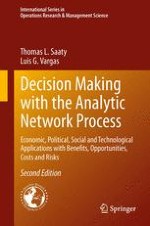The Analytic Network Process (ANP), developed by Thomas Saaty in his work on multicriteria decision making, applies network structures with dependence and feedback to complex decision making. This new edition of Decision Making with the Analytic Network Process is a selection of the latest applications of ANP to economic, social and political decisions, and also to technological design. The ANP is a methodological tool that is helpful to organize knowledge and thinking, elicit judgments registered in both in memory and in feelings, quantify the judgments and derive priorities from them, and finally synthesize these diverse priorities into a single mathematically and logically justifiable overall outcome. In the process of deriving this outcome, the ANP also allows for the representation and synthesis of diverse opinions in the midst of discussion and debate.
The book focuses on the application of the ANP in three different areas: economics, the social sciences and the linking of measurement with human values. Economists can use the ANP for an alternate approach for dealing with economic problems than the usual mathematical models on which economics bases its quantitative thinking. For psychologists, sociologists and political scientists, the ANP offers the methodology they have sought for some time to quantify and derive measurements for intangibles. Finally the book applies the ANP to provide people in the physical and engineering sciences with a quantitative method to link hard measurement to human values. In such a process, one is able to interpret the true meaning of measurements made on a uniform scale using a unit.
